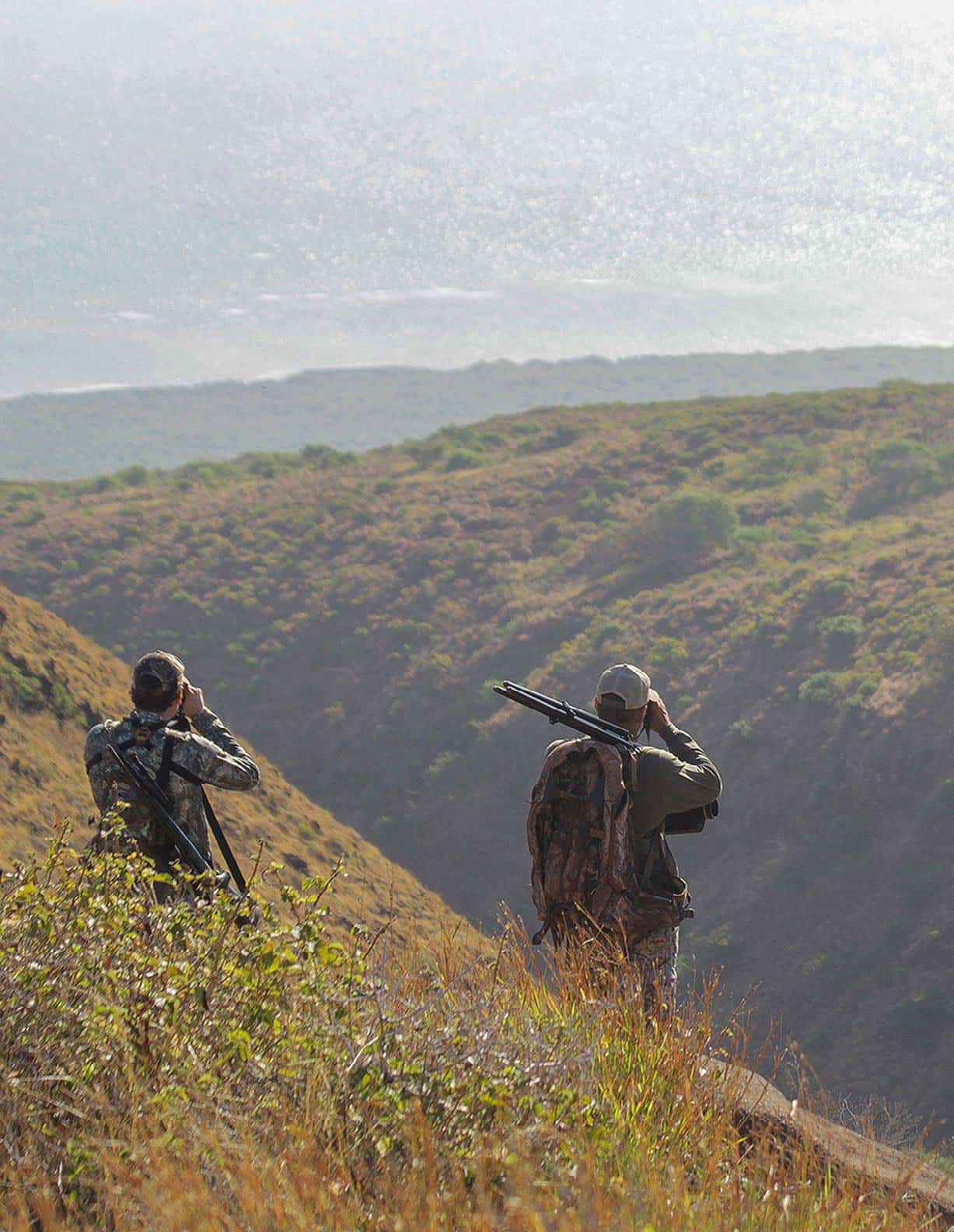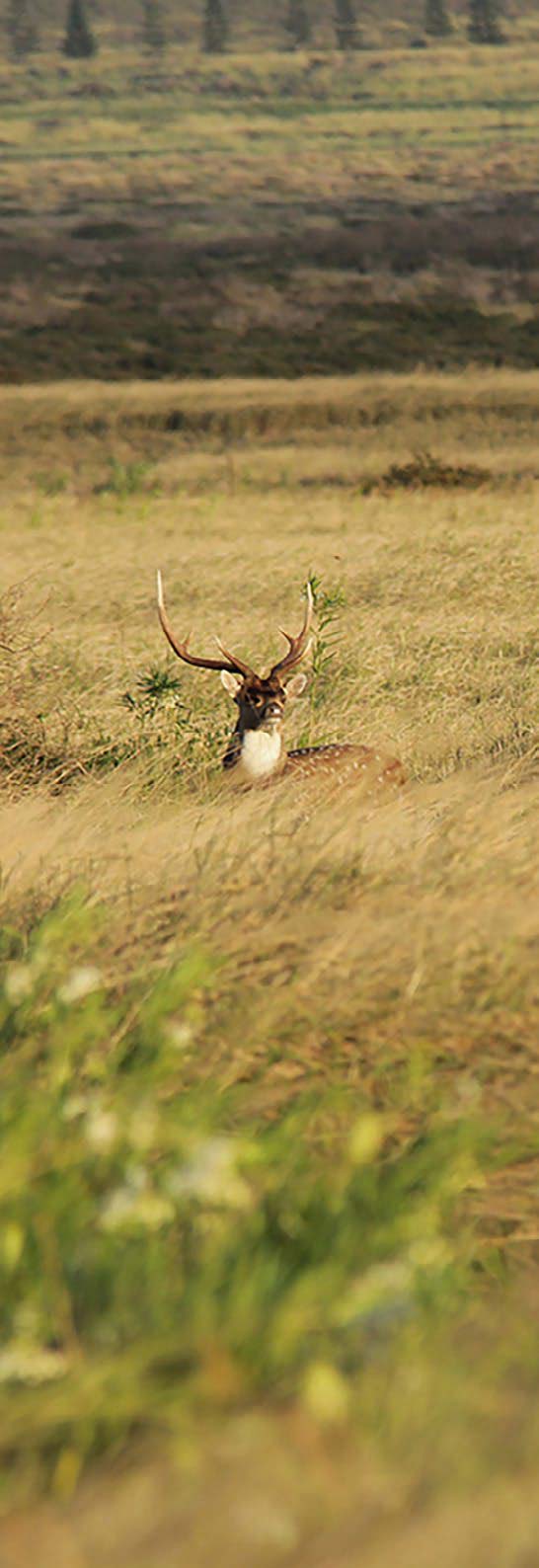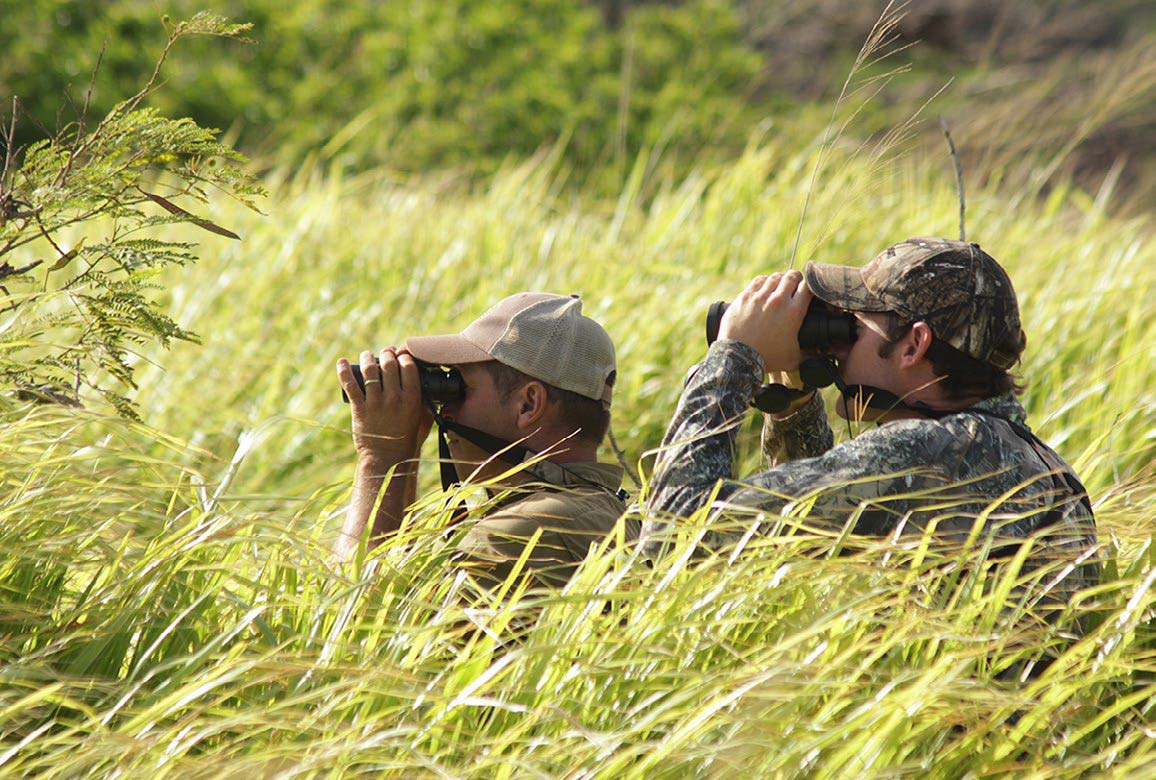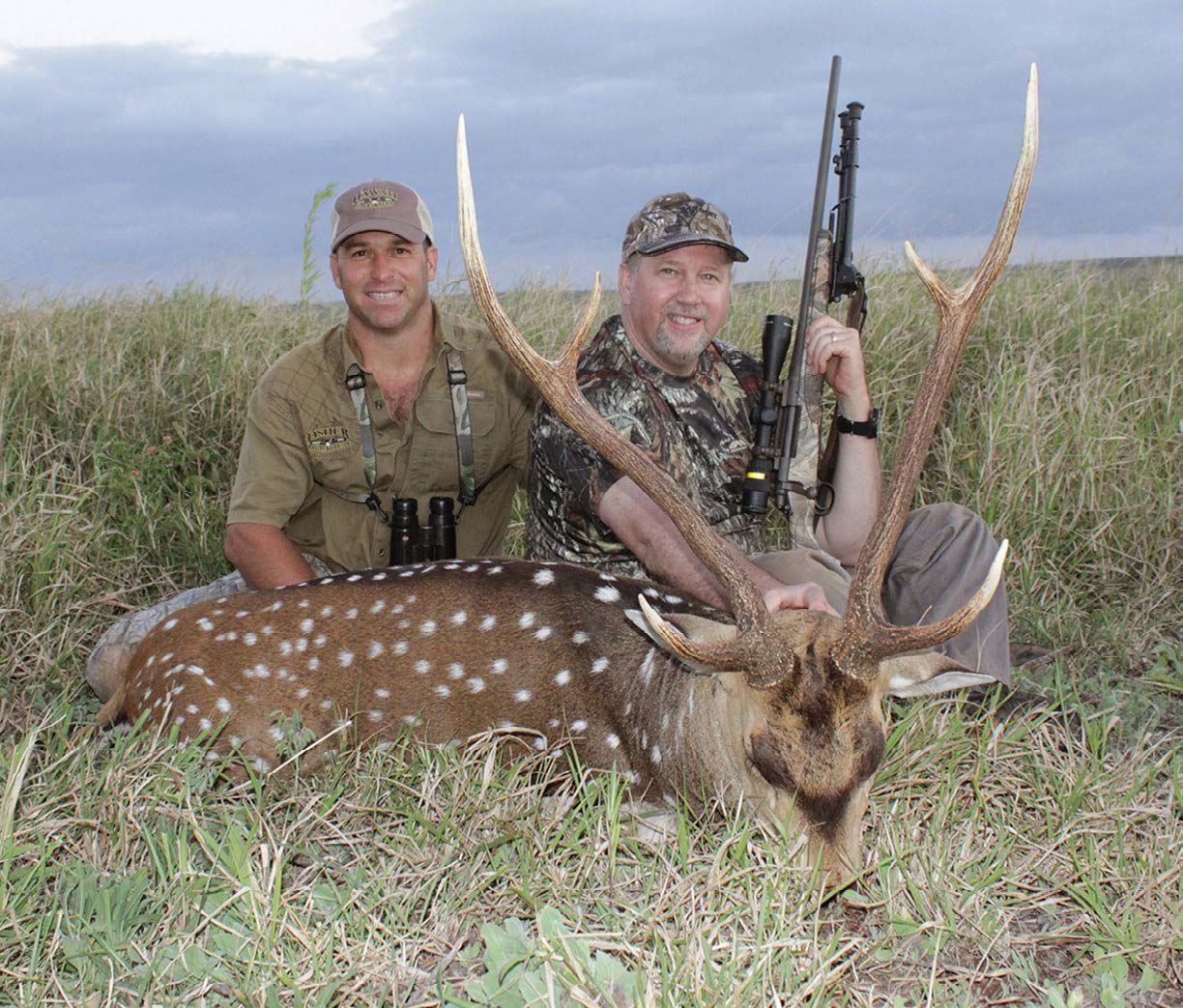Glassing from the edge of an expansive meadow, we searched for any sign of deer movement. “It won’t be long and they’ll start moving,” encouraged our guide, Pat Fisher, the owner of Hawaii Safaris.
Pat had warned us about getting afield too early, for he knew exactly when the deer would start moving. He also knew we were excited to be hunting in this magical land.
Three of us had traveled from different parts of the country in hopes of taking highly prized axis deer. First up was Tom Munson, then the director of sales and marketing for Trijicon in Michigan. This was Tom’s first hunt in Hawaii, and he was thrilled. I also held a tag, as did the third hunter in our party, Jeremy Vaccaro, who is from South Carolina.
We all sat on the edge of a red dirt trail, glassing for the spotted deer from our elevated vantage point. The grassy flat we studied was surrounded by tall, dense brush. During the day, deer would bed in the brushy thickets, then move into the fields to graze in the early evening.
Scouring the distant thickets, a few deer started to move. “Just wait, once they decide to feed, there’ll be herds of 200 deer coming out,” smiled Fisher. “The rut is also kicking in, so keep an eye out for bucks chasing does.”

Any time deer can be hunted in the rut, exciting moments and increased opportunities present themselves. That situation also keeps optimism levels high, for with surging amounts of testosterone coursing through the veins of big bucks, anything can happen.
With deer starting to move on the fringes, Pat suggested we inch closer. One herd moved slowly and had over 100 head. We knew it would be worth a closer look. Dropping into a ditch surrounded by tall grass, the going was easy, and we covered ground quickly.
The goal was to swiftly cut the 1,500 yards as much as possible. A few hundred yards into our stalk, we jumped a doe from the tall grass. Tight on her tail was a good buck. The tall grass rapidly swallowed them. We kept moving.
Moments later we jumped another doe, and this one had two bucks chasing her. “As these does go into heat, the bucks will single them out of the herd and they often rest in the tall grass,” Fisher shared. “With the grass being so high this year, the deer could be anywhere, so keep your eyes peeled.”
With above-average rainfall that spring on the island of Lanai, the grass was eight feet high and even more in some places, rather than being the normal couple of feet tall. We kept pushing, hoping to catch glimpses of deer as they scooted across short grass openings.
A quarter-mile into our stalk, a hot doe was being chased by a big buck, and they bedded down amid fairly short grass near a dense pocket of brush. “Let’s keep following this ditch, we should be able to get close,” Pat whispered. The strong, steady wind coming off the beach and hitting our faces kept our scent moving in the right direction and it helped squelch the noise of our footsteps. The waving grass also masked our movement.
Soon we were in position, and Tom wasted no time getting set in the shooting sticks. We were only 70 yards from the buck, but all we could see were antler tips barely sticking up above the grass. Though the grass was shorter than in most places, it was still tall enough to cover the buck.
We had no choice but to wait…and wait. An hour passed and the doe stood to stretch. Tom got ready for the shot, but the buck didn’t budge. The doe laid back down.
Minutes later the buck started getting fidgety and began grooming. “Get ready, Tom, lots of times when they start acting like that, they stand up,” Pat pointed out. Seconds later, the buck stood, still grooming its beautiful red coat covered in ivory spots. The moment the buck turned broadside. Tom made a perfect shot. Tom’s buck was stunning, and with antlers eclipsing the prized 30-inch mark, it was a great start to our hunt.

The Place
I’d hunted with Pat Fisher before, both on the Big Island and on Molokai. When out with him I had taken mouflon and Corsican sheep, Spanish goat, wild boar and axis deer. On this hunt, our efforts were focused primarily in the flats, on what once was one of the world’s largest pineapple plantations. Today, its vast, rolling hills of grass resemble an African savanna. With the pineapples gone, the rich soil and ample moisture create the perfect habitat for axis deer to thrive.
Indigenous to Asia and parts of the South Pacific, axis deer were brought to Hawaii in the 1800s as a gift from China to King Kamehameha. Today the deer are thick on Lanai, Molokai and are present in other places around the island state. Hunting can shift as private lands change hands and as herds expand and grow.
Herds numbering into the hundreds are common, and with favorable living conditions and no predators, herds keep growing. Axis deer keep their spots all of their life and offer what many consider to be the finest eating game meat on the planet. I’ve seen axis deer in India, Indonesia, Australia and other places around the Pacific Rim. Everywhere, they are revered for their beauty and fine table fare; Hawaii is no different.

Mouflon & Axis Double
Jeremy took a nice mouflon sheep on the first day of his hunt. That hunt found us high atop Lanai’s rugged mountains, where we actually saw more axis deer than sheep. I was struck by how high these deer lived and how daunting the habitat was. Parts of it reminded me of mountain ranges I’d hunted in Alaska and throughout the West. The land was rocky, rugged and steep.
Though Jeremy had his choice of a few bucks in the upper 20-inch range, he passed, focusing instead on securing a mouflon ram. Jeremy took a ram in the closing minutes of daylight. Packing that ram out wasn’t easy and it took hours. Steep terrain, loose lava rock, sharp grass, thorn-covered bush and lantana thickets made it worse. Those images are not something you envision when you think about hunting in Hawaii.
The following morning we were up early, glassing the flats where Tom had taken his axis buck. Not wanting his hunt to end early, Jeremy passed up several opportunities at bucks that morning.
After lunch and a dip in the pool, we were back at it, glassing the expansive grass meadows. “Let’s get some elevation and see if we can spot anything moving,” Fisher suggested. Reaching a high dirt mound, we found a herd, but they were content feeding along the edge of a thicket; they were not moving into the grass field.
We needed to get closer, for at the rate they were feeding out, they wouldn’t get within shooting range by dark. We used tall grass, bushes and rolling terrain to our advantage and moved quickly.
With only 15 minutes of shooting light left, we didn’t have time to wait for the deer to move to us, so we kept pushing. We closed the gap to 300 yards, that’s as close as we could get. Then two bucks started to fight. Antlers clashing, dirt and fur flying, the rut-crazed bucks worked into some short grass.
Feeling solid in the sticks, Jeremy was confident. At 272 yards, the shot was perfect. Jeremy’s buck carried 32 inches of antler—rating as a monster buck wherever axis deer roam.

Velvet Quest
Having hunted free-range axis deer in other countries and on different islands in Hawaii, I was eager for something unique. We’d been seeing a few bucks still in velvet. Given how they were alone or in small bachelor groups, Pat and I felt up to the challenge.
A day of searching brought us to the final evening of the hunt. Though we saw some giant bucks, with some of them spanning into the mid-30-inch class, I held out, hoping to find a buck in velvet. Finally, with just over an hour remaining, we found what we’d to discover.
While the rest of the herds were up feeding, we watched two lone bucks in velvet, bed down. In a rush to cut the distance before they stood, Pat and I covered more than a half-mile. Sweating and puffing for air, we quickly caught our breath and slithered from brush pile to brush pile, getting closer with each step. The wind was good and the setting sun was at our back. The grass was taller than expected, covering the bedded bucks. Getting a shot wasn’t going to be easy.
“We can’t be more than 100 yards from ‘em,” Pat whispered. “Let’s move there and see if we can find a shooting gap,” Pat pointed. Wiggling to a place where the grass was short, I took a knee and got set in the shooting sticks. Peeking through binos, I could see the velvet-covered tips of an antler. Moments later the buck stood and I quickly picked it up in the scope.

I put the green dot of the Trijicon AccuPoint on a white spot, smack on the buck’s shoulder. The .270 roared, sending a 130-grain Nosler AccuBond on its way. The buck collapsed.
Wrapping my fingers around the soft, velvet rack was a longtime dream come true. The giant rack spanned 33 inches and it was the biggest-bodied axis deer I’d ever seen. The fact that the buck hadn’t been rutting made for one of the best-eating big game animals I’d tasted.
Our time on Lanai will never be forgotten. We remember the warm weather, friendly faces and some of the most beautiful hunting grounds we’d ever seen. That’s just the start of what makes hunting axis deer in Hawaii so special.
Per our affiliate disclosure, we may earn revenue from the products available on this page. To learn more about how we test gear, click here.



